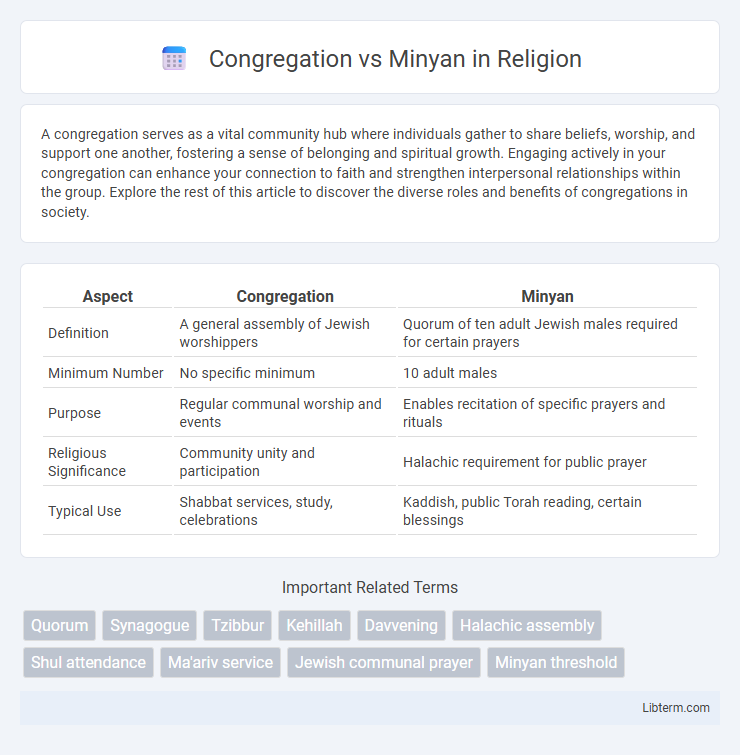A congregation serves as a vital community hub where individuals gather to share beliefs, worship, and support one another, fostering a sense of belonging and spiritual growth. Engaging actively in your congregation can enhance your connection to faith and strengthen interpersonal relationships within the group. Explore the rest of this article to discover the diverse roles and benefits of congregations in society.
Table of Comparison
| Aspect | Congregation | Minyan |
|---|---|---|
| Definition | A general assembly of Jewish worshippers | Quorum of ten adult Jewish males required for certain prayers |
| Minimum Number | No specific minimum | 10 adult males |
| Purpose | Regular communal worship and events | Enables recitation of specific prayers and rituals |
| Religious Significance | Community unity and participation | Halachic requirement for public prayer |
| Typical Use | Shabbat services, study, celebrations | Kaddish, public Torah reading, certain blessings |
Defining Congregation and Minyan
A congregation typically refers to a group of Jewish individuals who gather regularly for communal worship, study, or social activities, encompassing all attendees regardless of number. A minyan, defined as the quorum of ten Jewish adults required for certain religious obligations, represents the minimum number needed to conduct specific prayers and rituals. Understanding the distinction highlights that while all minyans are part of a congregation, not every congregation constitutes a minyan.
Historical Origins of the Minyan
The concept of the Minyan originates from ancient Jewish law, establishing a quorum of ten adult males required for certain communal prayers and religious rituals, ensuring collective worship and communal responsibility. Historically traced back to the Talmudic era, the Minyan formalized the transition from individual to organized group prayer, reflecting the social and religious dynamics of early Jewish communities. This quorum stands distinct from a general congregation, highlighting a specific number of participants necessary for the sanctification of communal prayers and certain religious ceremonies.
The Role of a Congregation in Jewish Life
The role of a congregation in Jewish life extends beyond assembling a minyan, serving as a vibrant community that fosters spiritual growth, education, and mutual support among its members. A congregation provides regular prayer services, Torah study, lifecycle event celebrations, and social activities that strengthen Jewish identity and continuity. It also acts as a communal framework that ensures religious obligations are met collectively, promoting unity and shared responsibility within Jewish tradition.
Legal Requirements for a Minyan
A minyan, the quorum of ten Jewish adults required for certain religious obligations, is legally mandated by halacha (Jewish law) to facilitate communal prayers, Torah readings, and significant rituals such as the Kaddish. Unlike a general congregation, which can vary in size and composition, the minyan must consist of ten men over the age of 13 in Orthodox practice, reflecting a higher standard for communal worship and legal compliance. This legal requirement ensures the fulfillment of commandments tied to communal participation and is foundational for legitimizing public worship in synagogue settings.
Gender and Minyan: Traditional and Contemporary Views
In traditional Jewish practice, a minyan requires the presence of ten adult males to conduct certain prayers, reflecting a gender-specific criterion rooted in halachic standards. Contemporary perspectives challenge this norm by including ten adult individuals regardless of gender, promoting egalitarian participation in communal worship. Debates around gender and minyan highlight ongoing tensions between preserving Orthodox halachic interpretations and embracing inclusive, progressive values in modern Jewish communities.
Congregational Structure and Leadership
Congregation structure typically includes a formal leadership hierarchy with roles such as rabbi, cantor, and board members responsible for spiritual guidance and administrative decisions. A minyan, the quorum of ten Jewish adults required for certain prayers, often operates within this larger congregational framework but lacks its own independent leadership structure. Leadership in a congregation ensures organized religious services, educational programs, and community outreach, while a minyan focuses solely on fulfilling specific prayer requirements.
Spiritual Significance of Praying with a Minyan
Praying with a minyan, the quorum of ten Jewish adults required for certain communal prayers, holds profound spiritual significance in Judaism. It fosters a powerful sense of unity and divine presence, as many prayers, including the Kaddish and Kedushah, can only be recited in a minyan, enhancing communal sanctity and connection. The collective intention and voice amplify spiritual energy, embodying the principle that communal worship transcends individual prayer in elevating holiness.
Community Dynamics: Minyan vs Congregation
A minyan, consisting of ten adult Jewish individuals, serves as the essential quorum for communal prayer, emphasizing active participation and collective responsibility within a small group. In contrast, a congregation represents a broader, more formalized community structure that supports diverse religious, educational, and social activities beyond prayer services. The dynamic between minyan and congregation highlights the balance between intimate, ritual-focused gatherings and larger organizational frameworks fostering sustained community engagement.
Special Occasions Requiring a Minyan
Certain Jewish rituals and prayers, such as reciting the Kaddish, reading the Torah, and performing the public Mourner's Kaddish, require a minyan, which is a quorum of ten adult Jewish males according to Orthodox tradition or ten adults in some other denominations. Special occasions like Yom Kippur services, funerals, and certain life-cycle events mandate a minyan to fulfill religious obligations properly. While a congregation refers broadly to any assembly of worshippers, a minyan specifically denotes the necessary number for communal prayer, emphasizing its critical role during these solemn and significant occasions.
Modern Adaptations of Congregation and Minyan
Modern adaptations of congregations and minyans reflect evolving community needs and technology integration. Virtual minyans utilize video conferencing platforms to facilitate prayer services for dispersed members, maintaining quorum requirements despite physical distance. Hybrid congregational models combine in-person gatherings with digital participation, enhancing accessibility and inclusivity in contemporary Jewish worship.
Congregation Infographic

 libterm.com
libterm.com